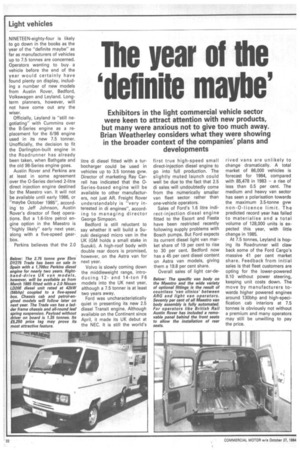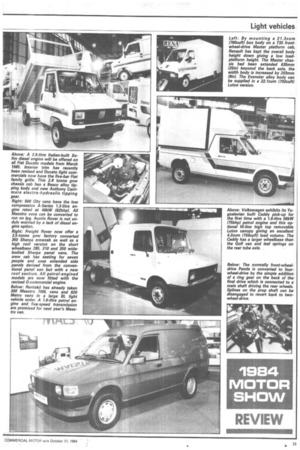The year of the 'definite maybe'
Page 28

Page 29

If you've noticed an error in this article please click here to report it so we can fix it.
Exhibitors in the light commercial vehicle sector were keen to attract attention with new products, but many were anxious not to give too much away. Brian Weatherley considers what they were showing in the broader context of the companies' plans and developments
NINETEEN-eighty-four is likely to go down in the books as the year of the "definite maybe" as far as manufacturers of vehicles up to 7.5 tonnes are concerned. Operators wanting to buy a vehicle before the end of the year would certainly have found plenty on display, including a number of new models from Austin Rover, Bedford, Volkswagen and Leyland. Longterm planners, however, will not have come out any the wiser.
Officially, Leyland is "still negotiating" with Cummins over the B-Series engine as a replacement for the 6/98 engine used in its new 7.5 tonner. Unofficially, the decision to fit the Darlington-built engine in the Roadrunner has already been taken, when Bathgate and the old 98-Series engine goes.
Austin Rover and Perkins are at least in some agreement over the 0-Series derived 2-litre direct injection engine destined for the Maestro van. It will not be available until early 1986, or "maybe October 1985", according to Jeff Johnson, Austin Rover's director of fleet operations. But a 1.6-litre petrol engine option in the Maestro is "highly likely" early next year, along with a five-speed gearbox.
Perkins believes that the 2.0
Below: The 2.75 tonne gvw Ebro. DY275 Trade has been on sale in Spain with a 1,700cc Perkins diesel engine for nearly two years. Righthand-drive UK van models, however, will be available as from March 1985 fitted with a 2.0 Nissan LD2OE diesel unit rated at 42kW (56bhp) coupled to a five-speed box. Chassis cab and petrol-engined models will follow later on next year. The Trade van has a ladder frame chassis and all-round leaf spring suspension. Payload without driver on board is 7.35 tonnes. its £5,250 price tag may prove its most attractive feature.
litre di diesel fitted with a turbocharger could be used in vehicles up to 3.5 tonnes gvw. Director of marketing Ray Carrell has indicated that the 0Series-based engine will be available to other manufacturers, not just AR. Freight Rover understandably is "very interested in di engines", according to managing director George Simpson.
Bedford is still reluctant to say whether it will build a Suzuki designed micro van in the UK (GM holds a small stake in Suzuki). A high-roof body with double rear doors is promised, however, on the Astra van for next year.
Volvo is slowly coming down the middleweight range, introducing 12and 14-ton F6 models into the UK next year, although a 7.5 tonner is at least two years away.
Ford was uncharacteristically quiet in presenting its new 2.5 diesel Transit engine. Although available on the Continent since April, it made its UK debut at the NEC. It is still the world's first true high-speed small direct-injection diesel engine to go into full production. The slightly muted launch could well be due to the fact that 2.5 di sales will undoubtedly come from the numerically smaller van fleet sector rather than one-vehicle operators.
Sales of Ford's 1.6 litre indirect-injection diesel engine fitted to the Escort and Fiesta have been restricted recently following supply problems with Bosch pumps. But Ford expects its current diesel light van market share of 19 per cent to rise to 30 per cent. Bedford now has a 45 per cent diesel content on Astra van models, giving them a 19.8 per cent share.
Overall sales of light car-de Below: The specific van body on the Maestro and the wide variety of optional fittings is the result of countless 'van clinics' between ARG and light van operators. Seventy per cent of all Maestro van body assembly is fully automated. For operators like British Rail Austin Rover has included a removable panel behind the front seats to allow the installation of rear seats. rived vans are unlikely to change dramatically. A total market of 86,000 vehicles is forecast for 1984, compared with 85,478 in 1983 — a rise of less than 0.5 per cent. The medium and heavy van sector has seen a polarisation towards the maximum 3.5-tonne gvw non-0-licence limit. The predicted record year has failed to materialise and a total volume of 128,000 units is expected this year, with little change in 1985.
At 7.5 tonnes, Leyland is hoping its Roadrunner will claw back some of the Ford Cargo's massive 41 per cent market share. Feedback from initial sales is that fleet customers are opting for the lower-powered 8.10 without power steering, keeping unit costs down. The move by manufacturers towards higher powered engines around 130bhp and high-specification cab interiors at 7.5 tonnes is obviously not without a premium and many operators may still be unwilling to pay the price.
Above: A 2.5-litre Italian-built Sofim diesel engine will be offered on all Fiat Ducato models from March 1985. Interior trim has recently been revised and Ducat° light commercials now have the five-bar Fiat family grille. This 2.8 tonne gvw chassis cab has a Besco alloy tipping body and new Anthony Carrmore electro-hydraulic tipping gear.
Right: 500 City vans have the low compression A-Series 1.3-litre engine rated at 46kW (62bhp). All Maestro vans can be converted to run on lpg. Austin Rover is not unduly worried by a lack of diesel engine option.
Right: Freight Rover now offer a 3.5-tonne gvw factory converted 350 Sherpa crewcab as well as a high roof version on the short wheelbase 285, 310 and 350 widebodied Sherpa panel vans. The crew cab has seating for seven people and uses extended side panels derived from the conventional panel van but with a new roof section. All petrol-engined models are now fitted with the revised 0-commercial engine.
Below: Rentokil has already taken 300 Maestro 700L vans and 620 Metro vans in a large BL light vehicle order. A 1.6-litre petrol engine and five-speed transmission are promised for next year's Maestro van. Left: By mounting a 21.3curn (760cuft) box body on a T35 frontwheel-drive Master platform cab, Renault has kept the overall body height down giving a low loadplatform height. The Master chassis had been extended 635mm (25in) beyomd the back axle, the width body is increased by 203mm (8in). The Evenstar alloy body can be supplied in a 22.1cum (792cuft) Luton version.
Above: Volkswagen exhibits its Yugoslavian built Caddy pick-up for the first time with a 1.6-litre 56kW (75M()) petrol engine and this optional Hi-line high top removable Luton canopy giving an excellent 4.2cum (150cuft) load volume. The Caddy has a larger wheelbase than the Goff van and leaf springs on the rear tube axle.
Below: The normally front-wheeldrive Panda is converted to fourwheel-drive by the simple addition of a ring gear on the back of the final drive which is connected to a main shaft driving the rear wheels. Splines on the prop shaft can be disengaged to revert back to twowheel-drive.


















































































































